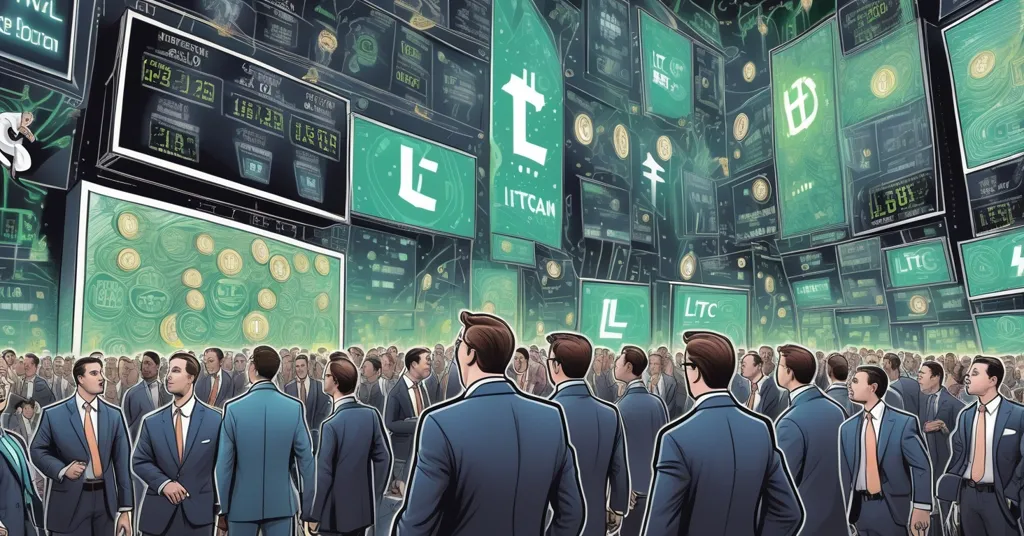Hedera and Litecoin ETFs Launch on NASDAQ, Outshining XRP and Dogecoin

Altcoin ETFs Break Through on NASDAQ: Hedera and Litecoin Steal the Show Over XRP and Dogecoin
Hold onto your hats, crypto fans—two underdog altcoins, Hedera (HBAR) and Litecoin (LTC), are about to make their Wall Street debut with exchange-traded funds (ETFs) launching on NASDAQ. This isn’t the hyped-up XRP or meme-fueled Dogecoin grabbing headlines; it’s a surprising pivot to projects with technical grit, signaling a new chapter for crypto’s push into mainstream markets. For more on this unexpected focus, check out this detailed report on altcoin ETFs.
- Launch Alert: Hedera (HBAR) and Litecoin (LTC) ETFs, managed by Canary Funds, kick off trading on NASDAQ this Tuesday.
- Shutdown? No Problem: A U.S. government shutdown won’t halt the rollout thanks to automatic regulatory filings.
- Bigger Picture: Solana ETFs and Grayscale’s GSOL conversion join the fray, hinting at a crypto ETF boom.
Crypto journalist Eleanor Terrett dropped the bombshell news, spotlighting Canary Funds as the driving force behind these ETFs. Steven McClurg, CEO of Canary Capital, didn’t mince words about the milestone, framing these launches as the next big leap after Ethereum’s ETF breakthrough. His enthusiasm underscores how far the industry has come in bridging the gap between decentralized tech and traditional investment avenues.
“Litecoin and Hedera are the next two token ETFs to go live after Ethereum. We look forward to launching tomorrow,” said Steven McClurg, CEO of Canary Capital.
For those just stepping into the crypto space, let’s unpack what an ETF means here. An Exchange-Traded Fund is essentially a financial wrapper that tracks the price of an asset—like Hedera or Litecoin—and trades on stock exchanges such as NASDAQ. It’s a game-changer because it lets everyday investors and big institutions gain exposure to these cryptocurrencies without messing with wallets, private keys, or sketchy exchanges. Think of it as a shortcut to owning digital assets through your standard brokerage account, blending the chaotic energy of crypto with the polished world of legacy markets.
What’s got everyone buzzing isn’t just the launch itself, but the timing. The U.S. is in the middle of a government shutdown, a mess that usually grinds regulatory gears to a halt. So how are these ETFs getting the green light? It boils down to clever legal mechanisms. The filings involved—known as 8-A and S-1—don’t need a bureaucrat’s stamp of approval to go live. The 8-A registers the ETF shares under the Securities Exchange Act of 1934 for trading on exchanges, while the S-1, under the 1933 Securities Act, can automatically take effect after a 20-day wait. Picture it as pre-approved paperwork running on autopilot, no boss’s signature required. The New York Stock Exchange (NYSE) has already certified the 8-A filings, clearing the last barrier before these ETFs hit the market.
Bloomberg’s ETF guru Eric Balchunas doubled down on the momentum, confirming that the stage is set not just for Canary’s Hedera and Litecoin ETFs on Tuesday, but also for Bitwise’s Solana ETF and Grayscale’s GSOL conversion rolling out Wednesday. Still, he threw in a cautionary note about potential last-minute drama.
Eric Balchunas noted via social media: “Listing notices for Bitwise Solana, Canary Litecoin, Canary HBAR, and Grayscale’s GSOL are out, everything looks ready unless there’s a last-minute SEC intervention.”
That SEC mention isn’t just idle chatter. The Securities and Exchange Commission has a notorious habit of playing spoiler to crypto’s party, often waving the flag of investor protection or market chaos as justification. While the self-executing nature of these filings lowers the odds of a delay, don’t be shocked if the SEC swoops in with a last-second veto. It’s a stark reminder that even as crypto claws its way into regulatory legitimacy, the path is littered with potholes.
Why Hedera and Litecoin? Unpacking the Chosen Ones
Let’s zoom in on the stars of this show: Hedera (HBAR) and Litecoin (LTC). If you’re new to the game, Litecoin is a veteran altcoin, often called Bitcoin’s silver to BTC’s gold. Born in 2011 under Charlie Lee’s vision, it’s built for speedier transactions and cheaper fees than Bitcoin, positioning it as a practical tool for everyday payments. Hedera, meanwhile, is a newer contender with a twist—it runs on something called Hashgraph, a tech that’s less like a traditional blockchain and more like a hyper-efficient gossip network, spreading data fast and cheap. Hedera’s focus is on enterprise solutions, backed by a governing council featuring heavyweights like IBM and Google, making it a darling for big business use cases.
Here’s the head-scratcher: why did Canary Funds pick these two over crowd-pleasers like Dogecoin or XRP? It’s not spelled out, but let’s speculate with some grounded reasoning. Litecoin offers proven longevity and a relatively drama-free history, unlike XRP, which is tangled in a brutal legal battle with the SEC over whether it’s a security. Hedera, with its corporate appeal and innovative tech, might signal to investors a safer bet on blockchain’s future beyond pure speculation. Dogecoin, while a cultural phenomenon, lacks the technical heft or serious adoption to justify an ETF—at least for now. Canary’s choice could also reflect a hedge against regulatory blowback, opting for altcoins less likely to draw scrutiny. Still, without insider clarity, we’re left guessing if this is pure strategy or just a dartboard pick.
A Regulatory Minefield: Risks Beyond the Hype
Stepping back, these launches fit into a larger wave of crypto ETFs gaining ground. Bitcoin and Ethereum already smashed through Wall Street’s gates with their own ETFs, proving there’s appetite for digital asset exposure among traditional investors. Now, with Hedera, Litecoin, Solana, and Grayscale’s GSOL in the mix, it feels like the floodgates are creaking open. This isn’t just about a couple of altcoins—it’s a tectonic shift toward normalizing blockchain-based investments in the U.S. financial system, potentially pulling billions in fresh capital into the space.
But let’s slam the brakes on the hype train for a second. Yes, the upside is massive, but the risks are just as real. First, there’s the ever-looming shadow of SEC meddling, as Balchunas pointed out. Beyond that, altcoins aren’t Bitcoin—they don’t have the same battle-tested resilience or market depth. Hedera and Litecoin can swing wildly in price on a single tweet or rumor, and ETF investors might not grasp they’re signing up for a rollercoaster, not a savings bond. Then there’s liquidity risk—will these ETFs attract enough trading volume to avoid price slippage or manipulation? And don’t get me started on the shillers and scam artists who’ll swarm this news with “$10,000 HBAR incoming!” garbage. We’ve got zero tolerance for that nonsense. If someone’s peddling moonshot predictions, they’re likely just hunting for your wallet—steer clear.
The Bigger Picture: Decentralization Meets Wall Street
As a fierce advocate for decentralization, privacy, and shaking up the old guard, I can’t help but cheer this milestone. Crypto ETFs are a defiant jab at the gatekeepers of finance, democratizing access to revolutionary tech and letting everyday folks bypass the bloated banking system. They’re a stepping stone toward effective accelerationism—pushing blockchain into the mainstream at warp speed. Yet, I’m not blind to the irony. Wrapping decentralized assets in centralized ETFs feels like dressing a punk rocker in a suit for a boardroom meeting. Are we sacrificing crypto’s rebellious soul for Wall Street’s nod of approval? It’s a valid critique, especially for Bitcoin maximalists who see altcoins and ETFs as distractions from BTC’s pure vision as sound money. I lean toward maxing out on Bitcoin myself—it’s the unshakable king for good reason—but I also see value in a diverse ecosystem. Litecoin’s quick transactions and Hedera’s enterprise focus tackle niches Bitcoin doesn’t, and shouldn’t, touch. There’s space for coexistence, even if BTC remains the guiding light.
Another devil’s advocate point to chew on: are ETFs the Trojan horse crypto needs to topple financial giants, or just another speculative bubble in a pinstripe disguise? Historical data offers a mixed bag—Bitcoin ETFs saw massive inflows post-launch, with billions pouring in within months, but altcoins are a dicier bet with less predictable demand. If these ETFs flop or spark a wave of uninformed FOMO buying followed by crashes, it could tarnish crypto’s rep among traditional investors. On the flip side, success here might pave the way for even more niche tokens to get ETF treatment, further eroding barriers to adoption. We’re at a crossroads, watching history unfold in real time on NASDAQ’s ticker screens.
Key Questions and Takeaways
- What altcoin ETFs are launching on NASDAQ, and when?
Hedera (HBAR) and Litecoin (LTC) ETFs, managed by Canary Funds, are set to begin trading this Tuesday. - How do these ETFs launch during a U.S. government shutdown?
Legal filings like 8-A and S-1 are designed to take effect automatically after a set period, no active government approval needed. - Why were Hedera and Litecoin selected over altcoins like XRP or Dogecoin?
While not confirmed, it may be due to their technical strengths, longevity, or lower regulatory risk compared to legally embroiled or speculative coins. - What are the major risks of investing in these altcoin ETFs?
Volatility of altcoins, potential SEC interference, and liquidity issues could pose significant challenges for investors. - What does this mean for the future of crypto in mainstream markets?
These launches mark deeper integration of digital assets into U.S. finance, potentially driving adoption while raising questions about centralization trade-offs.



